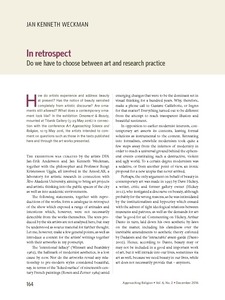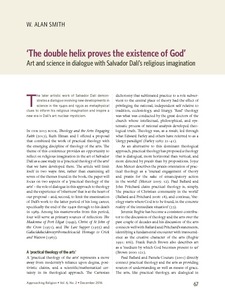Selaus syöttöajan mukaan kokoelmassa
Viitteet 1-19 / 19
-
Book reviews. Art and religion in contemporary society
(The Donner Institute, Åbo Akademi, 2016)Art + Religion in the 21st century by Aaron Rosen (2015) is reviewed by Malin Fredriksson. -
Reflections. In retrospect: do we have to choose between art and research practice
(The Donner Institute, Åbo Akademi, 2016)How do artists experience and address beauty at present? Has the notion of beauty vanished completely from artistic discourse? Are ornaments still allowed? What does a contemporary ornament look like? In the exhibition ... -
The aesthetic turn: exploring the religious dimensions of digital technology
(The Donner Institute, Åbo Akademi, 2016)The arena for developing digital technology has undergone an aesthetic turn, broadening the focus from a functionalist approach producing centralized systems in the 1970s and 1980s to an increased awareness of the aesthetic ... -
Dressing the dead body
(The Donner Institute, Åbo Akademi, 2016)My current research focuses on textiles and rites, especially woven textiles for funerals and moments of loss. What active role can a textile such as an infant-wrapping cloth or a funeral pall play in the mourning process? ... -
A cinematographic fence and ornamental oars: experiencing the sublime in structures of urban public space
(The Donner Institute, Åbo Akademi, 2016)I approach the theme of the sublime experience in public urban space from the point of view of a visual artist and from one of a person walking through the city. In this essay a concrete sublime experience in public urban ... -
A metabolism of Adam and Eve: Damien Hirst meets Edvard Munch
(The Donner Institute, Åbo Akademi, 2016)Evolution is a theme which crosses the boundaries of art, science and religion. In this paper the problematics of evolution are approached by analysing the works of Edvard Munch (1863–1944) and Damien Hirst (b. 1965). Key ... -
Iconography transformed: a few notes on the god Vaiśravaṇa
(The Donner Institute, Åbo Akademi, 2016)This article aims at an integration of the topic of iconographic transformation processes into a wider context of meaning, in order to enhance its importance from a religious and cultural-scientific point of view. In this ... -
Aesthetics as metaphysical meaning-making in the face of death
(The Donner Institute, Åbo Akademi, 2016)In my ethnographic research on death and dying in contemporary Finland, I explore how Finns facing end of life due to a long-term illness or other terminal condition seek to orient themselves and make meaning with cultural ... -
Towards an imaginal dialogue: archetypal symbols between Eastern Orthodox Christianity and Islam
(The Donner Institute, Åbo Akademi, 2016)This paper explores the potential for a dialogue between religious traditions based on art, in order to complement the dominant channels that rely on conceptual meanings. Building on a theoretical framework of post-Jungian ... -
'The double helix proves the existence of God': art and science in dialogue with Salvador Dali's religious imagination
(The Donner Institute, Åbo Akademi, 2016)The later artistic work of Salvador Dali demonstrates a dialogue involving new developments in science in the 1940s and 1950s as metaphysical clues to inform his religious imagination and inspire a new era in Dali’s art: ... -
Dance in the Early Church: sources and restrictions
(The Donner Institute, Åbo Akademi, 2016)Understanding the role of dance in the Western Christian tradition is an underexplored territory. Sources of historical investigations are few and many of them are problematic. In this article commonly used sources are ... -
[The Greeks] 'called it KOSMOS, which means ornament'
(The Donner Institute, Åbo Akademi, 2016)The title of this article is a statement quoted from a translation of The Etymologies of Isidore of Seville, 615–630 ad. The article proposes that the content of ornament is primordially derived from the eternal motions ... -
Response to Serafim Seppälä
(The Donner Institute, Åbo Akademi, 2016)A response to Serafim Seppälä’s article ‘The “Temple of Non-Being” at Tsitsernakaberd and remembrance of the Armenian genocide: an interpretation’. Key themes discussed include increasing efforts to convey divergent positions ... -
The 'Temple of Non-Being' at Tsitsernakaberd and remembrance of the Armenian genocide: an interpretation
(The Donner Institute, Åbo Akademi, 2016)This paper discusses and analyses the memorial complex of Tsitsernakaberd in Yerevan as an architectural and symbolic entity in relation to Armenian national identity in the aftermath of the Armenian genocide of 1915. How ... -
Response to Melissa Raphael
(The Donner Institute, Åbo Akademi, 2016)A response to Melissa Raphael’s article ‘The creation of beauty by its destruction: the idoloclastic aesthetic in modern and contemporary Jewish art’. Key themes discussed include the notion of human beings as created in ... -
The creation of beauty by its destruction: the idoloclastic aesthetic in modern and contemporary Jewish art
(The Donner Institute, Åbo Akademi, 2016)Contemporary commentators are well aware that the Jewish tradition is not an aniconic one. Far from suppressing art, the Second Commandment produces it. And not just abstract art; it also uses halakhically mandated ... -
The aesthetic turn
(The Donner Institute, Åbo Akademi, 2016)This paper considers alternative styles of philosophy, based on art or science, through an investigation of Rudolf Carnap and Martin Heidegger. Carnap’s criticism of Heidegger’s account of das Nichts is analysed in relation ... -
The opening words for symposium Art Approaching Science and Religion.
(The Donner Institute, Åbo Akademi, 2016)The opening words for symposium Art Approaching Science and Religion. -
Editorial. Art approaching religion and science
(The Donner Institute, Åbo Akademi, 2016)Editorial for the special issue on the theme of art appraoching religion and science.


















